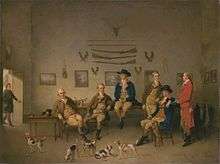Philip Reinagle
Philip Reinagle RA (1749 – 27 November 1833) was an English animal, landscape and botanical painter. The son of an Hungarian musician living in Edinburgh, Reinagle came to London in 1763 and after serving an apprenticeship, later became a member of the Royal Academy.
Biography

Philip Reinagle entered the schools of the Royal Academy in 1769, and later became a pupil of Allan Ramsay, whom he assisted on his numerous portraits of George III and Queen Charlotte.
He first exhibited at the Royal Academy in 1773, The works he showed were almost all portraits until 1785, when the monotonous work of producing replicas of royal portraits appears to have given him a distaste for portraiture, and led him to abandon it for animal painting. He became very successful in his treatment of sporting dogs, especially spaniels, of birds, and of dead game. In 1787, however, he showed a View taken from Brackendale Hill, Norfolk, at the academy and from then on exhibited works mostly landscapes. He was elected an associate of the Royal Academy in 1787, but did not become an academician until 1812, when he presented as his diploma picture An Eagle and a Vulture disputing with a Hyaena. He also exhibited frequently at the British Institution.[1]
Reinagle was also an accomplished copyist of the Dutch masters, and his reproductions of cattle-pieces and landscapes by Paul Potter, Ruisdael, Hobbema, Berchem, Wouwerman, Adriaen van de Velde, Karel Dujardin, and others have often been passed off as originals. He also made some of the drawings for Robert John Thornton's New Illustration of the Sexual System of Linnaeus (1799–1807), and for his Philosophy of Botany (1809–10) ; but his best drawings for book illustration were those of dogs for William Taplin's Sportsman's Cabinet (1803) which were engraved by John Scott.[1]

Reinagle died at 5 York Place, Chelsea, London, on 27 November 1833, aged 84. A drawing by him, 'Fox-hunting the Death', is in the collection of the Victoria and Albert Museum.
Family
In 1771 Reinagle married Jane Austin; they had nine daughters (Amelia Ann, Mary Ann, Jane, Charlotte Jenetta, Rachel Christiana, Frances Arabella, Caroline, Harriet, and Oriana Georgina), and two sons.[2]
Reinagle's daughter Frances Arabella was married to John Levett-Yeats, grandson of the English merchant and planter Francis Levett. His son, Ramsay Richard Reinagle, was also an artist, and followed his father's style.[1] The other son, Philip, went to Trinidad where he held posts including Surveyor of Port of Spain.[3] He was responsible for the design and construction of Holy Trinity Cathedral and the Cathedral Basilica of the Immaculate Conception there.[4]
Notes
- 1 2 3 Graves, R. E. (1896). "Reinagle, Philip (1749–1833), animal and landscape painter". Dictionary of National Biography Vol. IIL. Smith, Elder & Co. Retrieved 2008-02-27. The first edition of this text is available as an article on Wikisource:
 "Reinagle, Philip". Dictionary of National Biography. London: Smith, Elder & Co. 1885–1900.
"Reinagle, Philip". Dictionary of National Biography. London: Smith, Elder & Co. 1885–1900. - ↑ Corley, T. A. B. "Reinagle, Philip". Oxford Dictionary of National Biography (online ed.). Oxford University Press. doi:10.1093/ref:odnb/23352. (Subscription or UK public library membership required.)
- ↑ "The Trinidad almanac and public register, for the year of our Lord, 1827". University of Florida. 1827. p. 18. Retrieved 3 December 2016.
- ↑ Stark's Guide & History of Tr inidad (PDF) at p. 45
References
 This article incorporates text from a publication now in the public domain: "Reinagle, Philip". Dictionary of National Biography. London: Smith, Elder & Co. 1885–1900.
This article incorporates text from a publication now in the public domain: "Reinagle, Philip". Dictionary of National Biography. London: Smith, Elder & Co. 1885–1900.
External links
| Wikimedia Commons has media related to Philip Reinagle. |